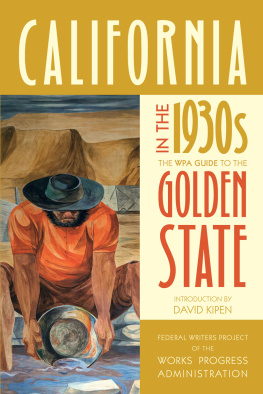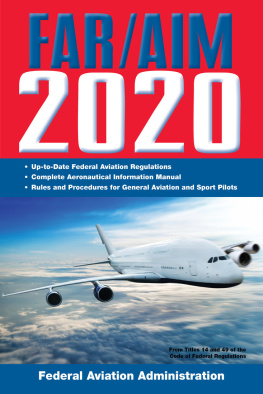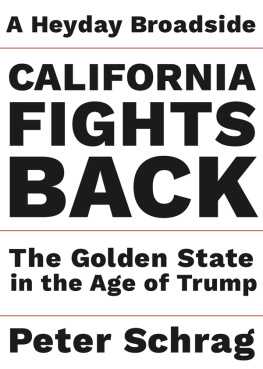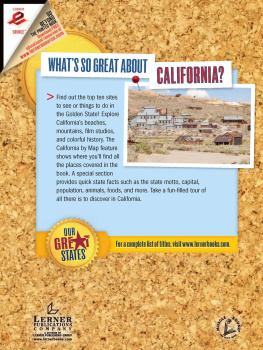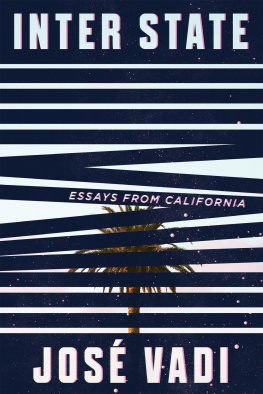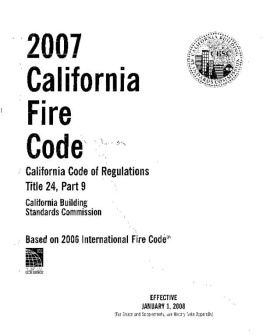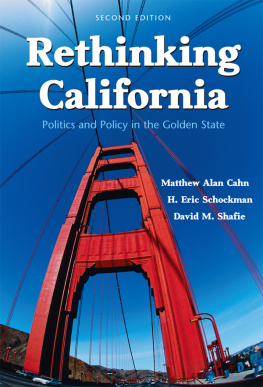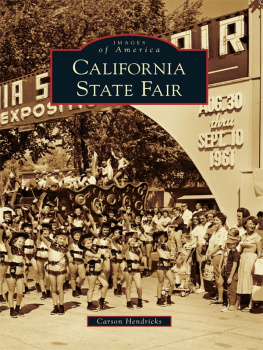
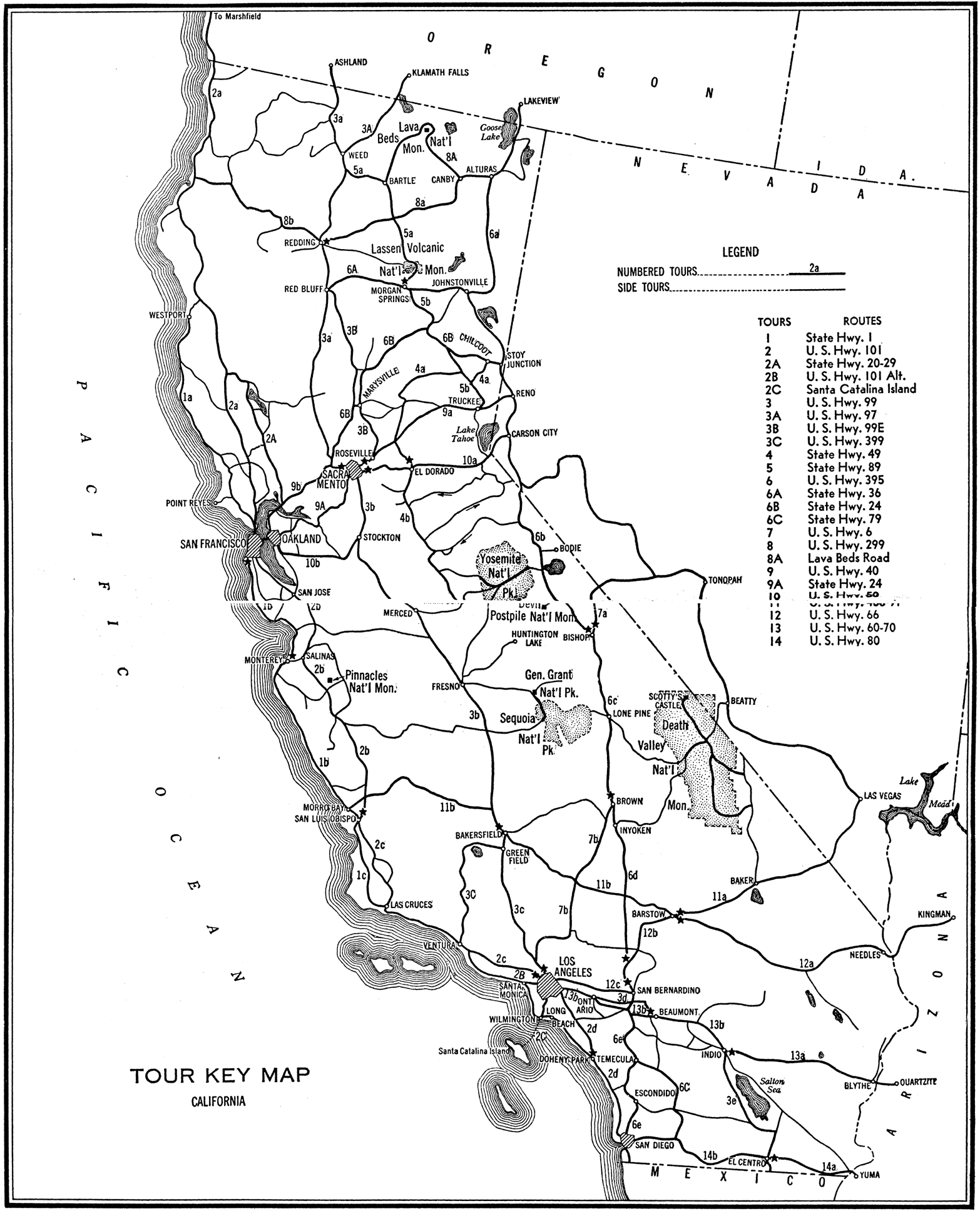
CALIFORNIA
IN THE 1930s
CALIFORNIA
IN THE 1930s
THE WPA GUIDE TO THE GOLDEN STATE
Federal Writers Project of the
Works Progress Administration
INTRODUCTION BY
David Kipen

UNIVERSITY OF CALIFORNIA PRESS
BERKELEYLOS ANGELESLONDON
University of California Press, one of the most distinguished university presses in the United States, enriches lives around the world by advancing scholarship in the humanities, social sciences, and natural sciences. Its activities are supported by the UC Press Foundation and by philanthropic contributions from individuals and institutions. For more information, visit www.ucpress.edu.
University of California Press
Berkeley and Los Angeles, California
University of California Press, Ltd.
London, England
Introduction and compilation 2013 by
The Regents of the University of California
ISBN: 978-0-520-27540-9
eISBN: 9780520954649
Works Progress Administration
F.C. Harrington, Administrator
Florence S. Kerr, Assistant Administrator
Henry G. Alsberg, Director of the Federal Writers Project
1939 by Mabel R. Gillis, California State Librarian
Manufactured in the United States of America
22 21 20 19 18 17 16 15 14 13
10 9 8 7 6 5 4 3 2 1
In keeping with a commitment to support environmentally responsible and sustainable printing practices, UC Press has printed this book on Rolland Enviro100, a 100% post-consumer fiber paper that is FSC certified, deinked, processed chlorine-free, and manufactured with renewable biogas energy. It is acid-free and EcoLogo certified.
Contents
Illustrations
Southern Pacific Historical Collection
Southern Pacific Historical Collection
Sculpture by Beniamino Bufano
Photograph by Theodore Baron
Watson Airfotos
Frashers
Horace Bristol
Horace Bristol
Bancroft Library
Behrman Collection
Behrman Collection
Bancroft Library U. of C.
Mary E. and Agnes H. Bemmerly, and the Woodland C. of C.
Hodson
Southern Pacific Railroad
Behrman Collection
Clyde Sunderland
Douglas Aircraft Company, Inc.
Bristol
Bristol
Bristol
Bristol
Theodore Baron
Luckhaus
Bristol
C. M. Johnson
Bret Weston
Standard Oil Company of California
U. S. Army Air Corps
Maps
General Information
Railroads: Southern Pacific Lines (SP), Western Pacific R.R. (Feather River Route), Northwestern Pacific R.R., Great Northern Ry., Atchison, Topeka & Santa Fe Ry. (Santa Fe), Sacramento Northern Ry., Union Pacific R.R. (overland Route).
Highways: Network of State highways and good country roads cover the State. Highway patrol to safeguard traffic and enforce regulations. Inspection at State Lines.
Bus Lines: Burlington Lines, Greyhound Lines, Santa Fe Trailways, Union Pacific Stages, Inland Stages, and Feather River Stages.
Air Lines: American Airlines, Inc., Pan American Airways Co., Transcontinental & Western Air Inc. (TWA), United Air Lines, Western Air Express. Los Angeles and San Francisco are terminals for transcontinental lines, San Francisco (Alameda Field) for the Pan American Airways service to Hawaii and the Philippines.
Waterways: Scheduled services to Alaska and Mexico, from San Francisco to Oregon and Washington, and from San Francisco to Sacramento.
Trails: The Pacific Crest Trail traverses the main divides of the highest mountain ranges in the three Pacific states. There are five sections of this trail in California: Lava Crest Trail, 330 miles; Tahoe Yosemite Trail, 260 miles; John Muir Trail, 185 miles; Sierra Trail, 160 miles; and Desert Crest Trail, 475 miles. All trails are open in July and Aug.; the southern trails from May through November. For information address Clinton C. Clark, President of the Pacific Crest Trail System Conference, 125 S. Grand Ave., Pasadena, Calif.
Traffic Regulations: Speed: 15 miles per hour at grade crossings, road intersections, and curves where the drivers view is obstructed; 15 miles per hour in passing schools where persons are entering or leaving; 20 miles per hour in business districts; 25 miles per hour in residential districts; 45 miles per hour under all other conditions.
Lights: Spotlights allowed. Headlights to be deflected or dimmed when passing other cars on the open road.
Licenses: Nonresidents must have operators license from their home States and must obtain visitors permits for their vehicles within 5 days. Licenses issued to adults, no fee; to minors 16 to 21 yrs. of age, with parental liability.
Required:Hand signals must be used. All accidents must be reported to some civic authority (police department in cities and towns). On narrow mountain roads the upgrade vehicle has the right-of-way.
Prohibited:Coasting in neutral, parking on highways, passing streetcars on left (in cities and towns), passing on curves or at crests of hills.
Trailers: All highways in State suitable for house and camp trailers, except steep and unimproved mountain roads. State and National parks, and trailer parks in some towns, have special facilities for trailers. Trailers are licensed according to weight. (For city ordinance governing trailers see Cities.)
Border Rules (digest):All persons returning to the United States from Mexico must make a declaration to the customs officers covering all goods and merchandise purchased in Mexico. Articles for personal or household use, up to the value of $100, are exempt from import duty. Exemption is allowed each person not more often than every 30 days. Cigars, cigarettes, tobacco, and foodstuffs may be included in the exemption, but the quantities are limited. American citizens wishing to visit any place farther south than Ensenada, or in the interior of Mexico, must obtain a tourist card (cost $1.01 in U. S. currency) from the nearest Mexican consul, or from the Mexican Immigration Office at the port of entry.
Accommodations: State is well provided with hotels, lodges, motor courts, housekeeping cabins, and campgrounds, both public and private. Recreation areas have large resort hotels, swimming pools, golf courses, tennis courts, and well-equipped campgrounds. State and National park campgrounds are equipped with necessary conveniences.
Regulations in Parks and Monuments: U. S. Forest Service offices in the parks or in cities and towns furnish maps and special information. Campfires, including fires in wood or oil stoves, are illegal without a permit, which will be issued free by the nearest forest officer. All camping parties in national forests must be equipped with a shovel (over-all length at least 26 in., head weight not less than 2 lbs.). During fire season (indicated by signposts) smoking is prohibited except in camps, at places of habitation, in special posted areas, and above 7,000 ft. elevation. Be careful to extinguish lighted matches, cigars, cigarettes, and pipe heels. Observe carefully all posted signs, particularly the No Smoking and the Closed Area signs. Build small fires. Clear an area of not less than 10 feet in diameter down to mineral soil, extinguish all fires with plenty of water. If garbage pits or incinerators are not provided, burn or bury all refuse. Do not pollute springs, streams, or lakes by unsanitary acts. Observe the fish and game laws. Drive carefully on mountain roads.
Next page
